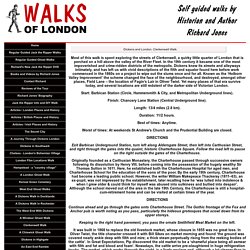

Sainsbury’s OFFICIAL Christmas Advert 2015 – Mog’s Christmas Calamity. Mog's calamity. Dickens and London. Clerkenwell Walk. (walks of london) Most of this walk is spent exploring the streets of Clerkenwell, a quirky little quarter of London that is perched on a hill above the valley of the River Fleet.

In the 19th century it became one of the most impoverished and crime-ridden districts of the metropolis. Dickens knew its streets and alleyways intimately, and has left us with vivid descriptions of the filth and squalor found here before work commenced in the 1860s on a project to wipe out the slums once and for all. Known as the ‘Holborn Valley Improvement’ the scheme changed the face of the neighbourhood, and destroyed, amongst other places, Field Lane – the location of Fagin’s Lair in Oliver Twist.
Yet many places of that era survive today, and several locations are still redolent of the darker side of Victorian London. Start: Barbican Station (Circle, Hammersmith & City, and Metropolitan Underground lines). Finish: Chancery Lane Station (Central Underground line). Length: 13/4 miles (2.8 km). Duration: 11/2 hours. Healthy Food Song for Children - Healthy Food Will Make You Smile - Debbie Doo. Fruit Song - Fruits Truck For Children,Preschoolers To Learn Different Fruit Names by JeannetChannel. La Scuola per i 150 anni dell'Unità d'Italia - Home.
La Scuola per i 150 anni dell'Unità d'Italia - Home. Animal Song For Children. Clothing Song for Kids. The Animals On The Farm. Super Simple Songs. Magnetism (Key Terms) flashcards Quizlet.
Faraday. Magnetism 6: Magnetic field due to current. RSA Animate - Changing Education Paradigms. Basics of Magnetism by Ron Kurtus - Succeed in Understanding Physics: School for Champions. SfC Home > Physics > Electricity and Magnetism > Key words: Magnetism, Physics, physical science, force, distance, magnetic field, electric charge, electron, magnet, ferromagnetism, iron, cobalt, nickel, Lorentz, attraction, repulsion, Ron Kurtus, School for Champions.

Copyright © Restrictions by Ron Kurtus (revised 29 January 2013) Magnetism is a force of attraction or repulsion that acts at a distance. It is due to a magnetic field, which is caused by moving electrically charged particles. A magnet is an object that exhibits a strong magnetic field and will attract materials like iron to it. Questions you may have include: What is a magnetic field? This lesson will answer those questions. Magnetic field A magnetic field consists of imaginary lines of flux coming from moving or spinning electrically charged particles. Magnetism for kids - A simple introduction. By Chris Woodford.

Last updated: November 5, 2017. Science is our understanding of how the world works—and generally the world works fine whether we understand it or not. Take magnetism, for example. People have known about magnets for thousands of years and they've been using them practically, as compasses, for almost as long. The ancient Greeks and Romans knew as well as we do that lodestone (an iron-rich mineral) can attract other pieces of iron, while the ancient Chinese were making magnetic compasses set in intricate wooden inlays for their practice of Feng Shui (the art of carefully arranging a room) thousands of years before interior designers came on board.
Photo: A typical horseshoe magnet. What is magnetism? Photo: The magnetic field between the opposite poles of two bar magnets that strongly attract one another. Playing with magnets is one of the first bits of science most children discover. To ancient people, magnetism must have seemed like magic. Blogging Is the New Persuasive Essay. As an English teacher, I’ve had numerous conversations with college professors who lament the writing skills of their first year students.

But not all writing. Most students are capable of solid expository writing. It’s their skill with persuasive writing that’s the problem. Specifically, they’re weak at writing a thesis statement that can be argued. I spend three years teaching my high school students how to write a persuasive essay. Part of the problem is that our current school systems — and not just in Canada — aren’t great at producing independent thinkers.
So for three years, I write for them, and with them. The truth is lately I’ve come to question the point of much of this. Blogging is a different beast While traditional essay writing may not help alleviate this situation, I think blogging can. For one, the paragraphing is different. Instead, blog paragraphs tend to be shorter.